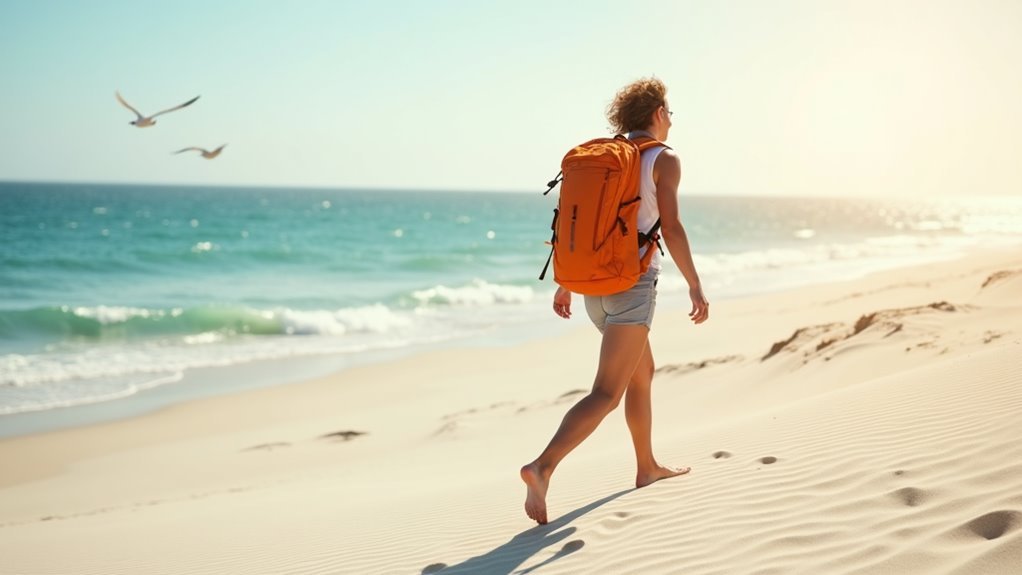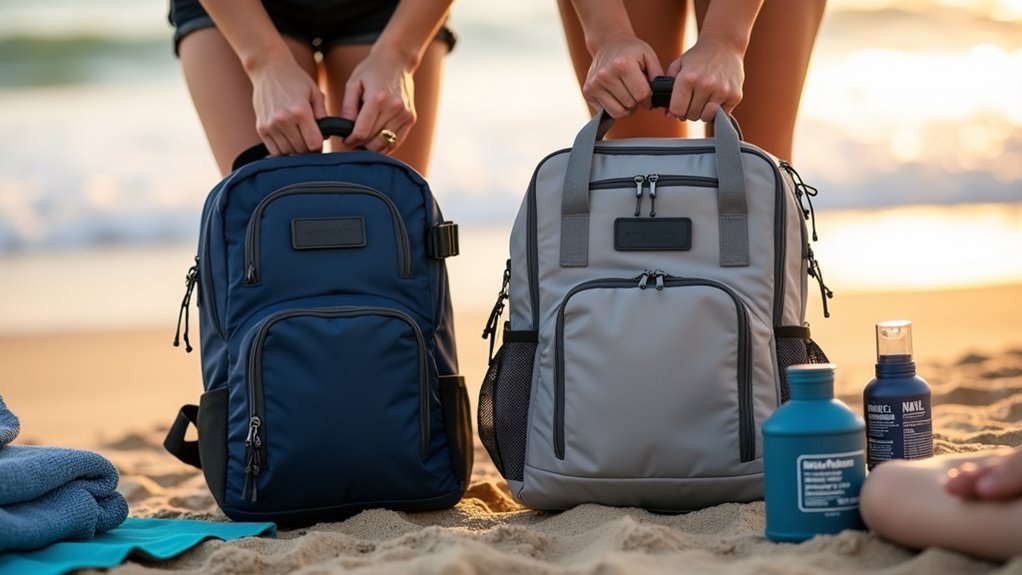I’ve found that choosing a lightweight beach backpack makes all the difference—perhaps even more than you’d expect. Every ounce matters when you’re trudging through sand, so I prioritize nylon or polyester materials with ripstop weaving for durability without the bulk. Day packs work perfectly for short trips, though I think you’ll want something larger for all-day adventures. Look for padded straps, multiple pockets for organization, and waterproof features to keep sand out. There’s actually quite a bit more to weigh when selecting your ideal beach companion.
Why Lightweight Design Matters for Beach Adventures

When you’re trudging through sand with a heavy pack digging into your shoulders, you quickly realize why weight matters more at the beach than perhaps anywhere else.
Sand doesn’t forgive a heavy pack—every step becomes a struggle when your gear weighs you down at the beach.
Sand shifts under every step, making you work twice as hard to maintain balance.
I think the difference becomes obvious after just a few minutes. A lightweight backpack lets you move freely over rocks or when you’re wading through deeper water.
You’ll conserve energy for longer walks along the shoreline instead of fighting against your gear.
It’s really about enhancing your mobility and keeping the adventure enjoyable rather than exhausting.
Types and Styles of Beach Backpacks
Since you’ve decided a lightweight design is worth prioritizing, the next step involves figuring out which style actually fits your beach plans.
I think the main categories break down pretty simply, though perhaps I’m oversimplifying.
Day packs work well for short beach hikes where you’ll access items frequently.
Travel packs offer more storage space, but honestly, they might be overkill unless you’re planning multi-day coastal adventures.
Traditional hiking bags with ripstop nylon construction seem most durable, though frameless options feel more flexible when you’re climbing over rocks or wading through tide pools unexpectedly.
Selecting the Right Size and Features

How much space do you actually need for a beach day?
I think it depends on your adventure style, honestly. A small daypack works perfectly if you’re just carrying sunscreen, snacks, and maybe a camera.
But perhaps you’re planning something bigger – then you’ll want more storage capacity.
Weight matters more than you’d expect.
That extra pound of gear becomes surprisingly noticeable when you’re trudging through sand for hours.
I’ve learned that even an extra pound feels heavy after miles of shoreline hiking.
Look for padded shoulder straps and, if possible, a hip belt for load distribution.
The right size should feel comfortable when loaded, though finding that sweet spot takes some trial and error.
Material Considerations for Durability and Performance
While countless features matter when selecting a beach backpack, I’d argue the fabric choice makes or breaks your entire experience. I’ve learned this the hard way through soggy gear and torn zippers.
Nylon and polyester dominate the market for good reason – they’re lightweight yet surprisingly tough. Look for ripstop varieties that resist tears from rocks or sharp shells.
Waterproof coatings matter too, though perhaps not as much as you’d think since sand gets everywhere anyway.
Don’t overlook the zippers and seams. I think quality stitching actually outlasts fancy fabric features in real-world beach conditions.
Frequently Asked Questions
How Do I Properly Clean and Maintain My Beach Backpack After Saltwater Exposure?
After saltwater exposure, I’ll rinse your backpack thoroughly with fresh water, then clean it using mild soap. I’ll air dry it completely before storage to prevent mold and corrosion damage.
What’s the Best Way to Organize Gear Inside a Beach Backpack?
I organize my beach backpack by placing waterproof items at the bottom, electronics in sealed pouches, snacks in easy-access pockets, and wet gear separately. This system keeps everything dry and lets me grab what I need quickly.
Can Beach Backpacks Be Used as Carry-On Luggage for Flights?
Most airlines allow bags up to 22x14x9 inches as carry-ons. I’d recommend checking your beach backpack’s dimensions first – many lightweight day packs easily fit these requirements, giving you travel freedom without extra fees.
How Do I Prevent Sand From Getting Into My Backpack Zippers?
I’ll choose a backpack with strong zippers and seams for moisture prevention. I’ll also look for durable materials like ripstop nylon that withstand sand’s abrasive effects during my adventures.
What Safety Items Should I Always Pack in My Beach Backpack?
I always pack sunscreen, a first aid kit, whistle, waterproof phone case, and emergency contact info. You’ll want a flashlight, extra water, and signaling mirror too. These essentials keep you safe during unexpected beach situations.
Conclusion
studies show the average beachgoer carries 40% more weight than necessary in their pack. I think that’s partly why so many people end up exhausted halfway through their coastal adventures.
Choosing the right beach backpack isn’t just about convenience—it’s about transforming your entire experience. Perhaps you’ll find, like I did, that the perfect pack makes those long shoreline treks feel effortless instead of grueling.